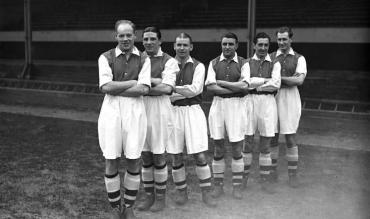Technically-speaking, it is correct to state that Arsenal have never been relegated from the top-flight of English football. That’s the good news to begin with, or at least it is for legions of Gooners who delight in boasting of such a claim.
The same goes for the pub quiz hosts who innocently enquire ‘Who is the only football team to have never experienced relegation from the top division of English football?’ and still think they’ll be home before midnight.
Technically-speaking, Arsenal have never been relegated from the top-flight of English football.
But then we must acknowledge the caveat, and we’re not talking here about a minor quibble, such as whether a player is onside, or off, and basing it on a knee-hair.
The caveat is a doozy, involving a name-change, and a change of location, not to mention the entire duration of the first World War, along with a highly dubious decision made by men in power.
These are the sticking points and they’re considerable ones. Perhaps though, it’s best if we highlight what occurred over a century ago and you can make your own mind up.
Going into WWI, Woolwich Arsenal were a second-tier club wracked by financial concerns, a plight made significantly worse by having the main stand of their Plumstead ground burnt to a cinder by protesting Suffragettes.
That’s Plumstead in southeast London incidentally. It’s an important detail.
In 1913, shortly before the world took up arms, the club finished rock-bottom of Division One, winning just three matches all season. That’s the relegation, right there. There’s the silver bullet.
Arsenal v Newcastle United 110 years ago. The match, played on 28 September 1912 at the Manor Ground in Plumstead, ended in a 1-1 draw. The home would endure a torrid season and eventually finished bottom of the table and were relegated. Newcastle came 14th. pic.twitter.com/1QzEihWlZt
— Football & the First World War (@FootballWW1) August 21, 2022
This was a team a great many lightyears away from the one who would go on to be invincible nearly a hundred years later, who even in times of crisis would feature prominently in the Premier League betting, being widely viewed as an elite club. In 1913, Woolwich Arsenal were a bit rubbish.
Enter though Henry Norris. Norris was a property developer and mayor of Fulham with influential connections, who took on the failing club in 1910, hoping to merge them with Fulham FC.
When his plan was foiled, he instead moved them north of the capital, securing a new ground – later known as Highbury – and changing their name to The Arsenal, soon after dropping the prefix.
At the cessation of the first world war, the football league decided to expand their top division by two teams and the obvious choices were the sides who finished third (Tottenham) or fourth (Wolves) in what is now the Championship.
Norris however, used his influence to ensure his club were chosen, leading to allegations of bribery and wrongdoing. Years later, Norris was banned from football for life for his unprincipled activities.
Once established in the top-flight, the Gunners never looked back. In 1925 they appointed Herbert Chapman resulting in an era of dominance and with plenty of money to spend, they purchased David Jack and Alex James, two of the greatest strikers in Arsenal’s history.
And thereafter they forever maintained a proud residency in the highest echelon of the football pyramid.
These days, EPL predictions routinely tip Arsenal for success in the form of a top four finish but way back when, they were a very different club, based in a very different part of London, with a slightly different name, and such riches would have been unimaginable. But fundamentally they are the same club, surely?
So, is it a myth to suggest Arsenal have never endured the drop because they did so as Woolwich Arsenal? Let’s just say that pub quiz host will be lucky to get home before dark.
*Credit for all of the photos in this article belongs to AP Photo*
FIRST PUBLISHED: 24th August 2022



